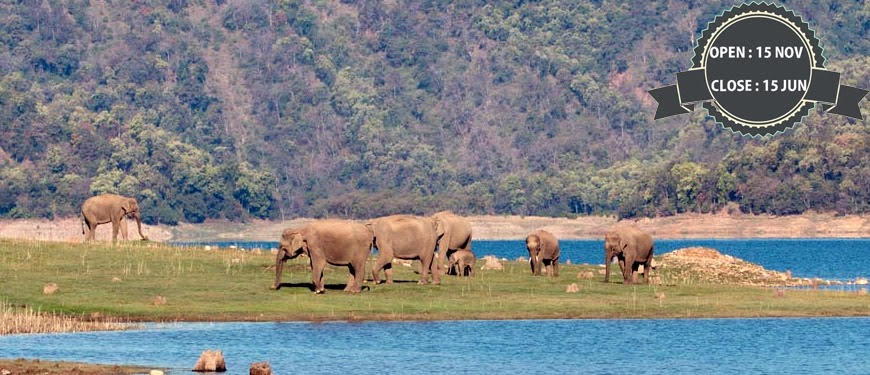Indian Environmentalists Establish First Biosphere in Tiger Reserve

Indian Environmentalists Establish First Biosphere in Tiger Reserve
The Rajaji Raghati Biosphere (RRB) and the upcoming project atop the Western Ghats symbolise a transformative approach to environmental conservation.
6th June 2024
World Environment Day, celebrated annually on 5th June, serves as a global platform for raising awareness and taking action on pressing environmental issues. With each passing year, the urgency of addressing environmental challenges, from climate change to biodiversity loss, becomes increasingly evident. As we commemorate World Environment Day, it is essential to recognise the interconnectedness between human activities and the health of the planet.
The Rajaji Raghati Biosphere (RRB) and the upcoming project atop the Western Ghats symbolise a transformative approach to environmental conservation. Through meticulous planning, community engagement and innovative reforestation techniques, Jai Dhar Gupta and Vijay Dhasmana are not only combating deforestation but also rejuvenating ecosystems and fostering biodiversity.
Let’s delve into their visionary endeavours, exploring the challenges, triumphs and broader significance of their efforts in shaping India’s environmental future.
Years back, Jai Dhar Gupta, a New Delhi-based entrepreneur, transitioned into a clean air advocate following his diagnosis of bronchial asthma. His mission was to raise awareness about the importance of ensuring clean air in our urban areas. He also played a significant role in the air pollution policy discussions within the Delhi Government, contributing to the implementation of measures like the odd-even vehicle rule.
The odd-even rule in Delhi is a traffic management strategy aimed at curbing air pollution. Under this rule, vehicles with odd-numbered registrations are permitted to operate on odd dates, while those with even-numbered registrations can operate on even dates. This measure is enforced by the Delhi government when the air quality index reaches ‘severe’ levels. Typically, it is implemented for a brief duration, often lasting a week or ten days.
In recent years, Jai has embarked on a new endeavour: establishing India’s first biosphere within a tiger reserve. Dubbed the Rajaji Raghati Biosphere (RRB), this initiative spans 35 acres and is spearheaded by ecologist Vijay Dhasmana, renowned for his efforts in rejuvenating the Aravalli landscapes. Jai, alongside Dhasmana, aims to revive rare and endangered species of indigenous trees while safeguarding the region from poaching and mining activities.
Located within the Rajaji National Park in Uttarakhand, the biosphere offers scenic views of the rugged white Raghati riverbed, nestled amidst the Shivalik foothills. Jai explains that when they initially took on the project, the designated land for RRB was barren and degraded.
“It had been previously flattened, disrupting natural contours and resulting in significant soil erosion. Additionally, the practice of monoculture agroforestry with non-native eucalyptus trees further deteriorated the ecosystem’s condition,” he told The Hindu. “Upon acquiring the land, thousands of non-native eucalyptus trees were swiftly removed. Following this, the terrain was reshaped to facilitate water retention, prevent erosion and encourage groundwater replenishment.”
Jai, alongside their team, conducted thorough surveys to pinpoint appropriate native plant species, particularly those that were rare or vanishing in the area. “We gathered seeds, established a seed bank and partnered with biodiversity parks to nurture and grow saplings of trees like haldu, rohini, mala, saal, jamun, pangana and others,” Jai explains. These saplings were subsequently planted throughout the biosphere. Additionally, Jai implemented a prohibition on combustion-engine vehicles within the region.
In 2023, the duo launched the initial phase of plantation, introducing around 80 species to the biosphere. “In the upcoming monsoon season,” Jai told The Hindu, “we aim to incorporate an additional 35 to 40 new species into the biosphere. However, the process of transforming the area into a flourishing forest ecosystem is gradual. It’s estimated to require another two to three years for the forest to truly resemble a natural habitat.”
Vijay emphasises the importance of considering how the plants will interact with the local wildlife, once the plantation is complete. “The end result,” Vijay explains, “will be a diverse array of forest communities within the land, possessing self-establishing and self-nurturing capabilities similar to those found in the neighbouring forest patch of the Rajaji Tiger Reserve.”
Jai highlights that the agricultural land’s objective surpasses merely combating climate change; it aims to create a model of harmonious coexistence. They emphasise their reliance on the expertise and traditional knowledge of the local nomadic community, the Gujjars.
Jai elaborates on the significance of biospheres like RRB for India, emphasising their role not just in combating deforestation but also in fostering forest growth. However, he acknowledges the challenges encountered in the process.
“Obstacles such as land acquisition, regulatory adherence and planning for long-term sustainability could hinder the broader acceptance of the private biosphere model,” Jai explains. “To unlock the potential of private biospheres, collaborative endeavours involving governments, private organisations and local communities are essential in surmounting these challenges.”
Jai and Vijay are also involved in establishing a second biosphere atop the Western Ghats, situated above the Koyna River within the buffer zone of the Sahyadri Tiger Reserve near Pune, Maharashtra. “This area presents a distinct habitat with unique topography and a diverse flora,” Jai explains. Their plans include cultivating species such as Lagerstroemia microcarpa (nana), Catunaregum spinosa (gela) and Ziziphus xylocarpa (torna), alongside other plant varieties.










